This Hidden Scheme Beats SCSS and Sukanya Samriddhi with the Highest Interest Rate – In a financial landscape crowded with government savings schemes like the Senior Citizen Savings Scheme (SCSS) and the Sukanya Samriddhi Yojana (SSY), a lesser-known investment option is quietly outperforming them with the highest interest rate currently available. As of May 2025, many investors are surprised to learn that a certain category of Fixed Deposits (FDs) from Small Finance Banks (SFBs) is offering returns up to 9%, making it one of the most lucrative safe investment options in India.

While SCSS and SSY remain top-tier government-backed schemes offering up to 8.2% interest, this “hidden” option appeals to both risk-aware and return-driven investors looking to grow their money faster — with a calculated, informed strategy.
This Hidden Scheme Beats SCSS and Sukanya Samriddhi with the Highest Interest Rate
| Feature | Details |
|---|---|
| Highest Interest Rate | Up to 9% (SFB FDs like Unity SFB, Equitas, Suryoday) |
| Popular Government Scheme Rates | SCSS & SSY: 8.2% (Apr–Jun 2025) |
| Scheme Type | Fixed Deposit from Small Finance Banks |
| Tenure Options | Ranges from 1 to 5 years (varies by bank) |
| Tax Benefits | SCSS/SSY: Tax-deductible under 80C; FDs: Optional (only 5-year tax-saving FDs) |
| Senior Citizen Advantage | SFBs often offer 0.5% extra interest to senior citizens |
| Minimum Deposit | As low as ₹1,000 depending on the bank |
| Official Resource | RBI List of Scheduled SFBs |
In 2025, Fixed Deposits from Small Finance Banks offer a smart alternative to traditional savings schemes like SCSS, SSY, or PPF, especially for investors chasing higher returns without entering volatile markets. While government schemes remain gold standards for safety and tax benefits, SFB FDs shine as the hidden gem in India’s investment landscape — provided you’re careful about limits, tenure, and the bank you choose.
Why This Scheme Stands Out in 2025?
High Returns in a Low-Volatility Instrument
The Fixed Deposits from Small Finance Banks (SFBs) are gaining popularity for offering up to 9% interest, surpassing well-known savings options like SCSS, SSY, and PPF (which offers 7.1%). Unity Small Finance Bank, for example, offers up to 9% p.a. for senior citizens, while Suryoday SFB and Equitas SFB offer 8.75–9% across selected tenures.
Unlike stocks or mutual funds, FDs offer capital protection — and with SFBs being regulated by the RBI, they’re considered reasonably safe for retail investors, especially when kept under the ₹5 lakh DICGC insurance limit.
Interest Rate Comparison Snapshot (April–June 2025)
| Scheme | Interest Rate | Risk | Lock-In | Backed By |
|---|---|---|---|---|
| SCSS | 8.2% | Low | 5 years | Government |
| SSY | 8.2% | Low | 21 years | Government |
| PPF | 7.1% | Low | 15 years | Government |
| SFB FDs (e.g., Unity, Equitas) | Up to 9% | Moderate | 1–5 years | RBI-regulated banks |
| National Savings Certificate (NSC) | 7.7% | Low | 5 years | Government |
What Are Small Finance Banks (SFBs)?
Small Finance Banks are RBI-licensed financial institutions created to promote financial inclusion. They primarily serve smaller towns, rural areas, and underserved populations.
However, in a bid to attract deposits, many SFBs now offer much higher FD interest rates than traditional banks. And with RBI oversight and DICGC insurance, your deposits are insured up to ₹5 lakh per bank.
Who Should Consider These High-Interest FDs?
1. Senior Citizens Seeking Income
Senior citizens can lock into high-yield FDs for regular income. For example, Unity SFB’s 5-year FD offers 9% interest, which is higher than SCSS’s 8.2%.
2. Parents Saving for Short-Term Goals
While SSY is great for long-term child education, a 3–5 year SFB FD might serve better for interim educational needs, especially with higher interest returns.
3. Young Investors Looking for Better Yields
If you’re risk-averse but still want better returns than PPF or NSC, SFB FDs offer a compelling balance of safety and growth — provided you split deposits across banks to stay within the ₹5 lakh insurance cover.
4. Investors Diversifying Fixed Income Portfolio
Those with exposure to bonds, debt mutual funds, and traditional bank FDs can use SFB FDs to boost blended fixed income returns without taking equity risks.
How to Invest in Small Finance Bank FDs?
Step-by-Step Guide
- Choose the Right SFB: Look at interest rates on official websites (e.g., Unity SFB, Equitas SFB, AU SFB).
- Compare Tenures and Rates: Select a tenure that fits your financial goals.
- Apply Online or Offline: Most SFBs offer online account creation and FD booking.
- Verify RBI License: Ensure the bank is listed under RBI’s scheduled SFB list.
- Stay Within ₹5 Lakh Insurance Limit: Open multiple FDs in different banks if needed.
- Check for Senior Citizen Rates: Ensure you’re getting the 0.5% bonus rate if you’re eligible.
What Are the Risks?
While returns are tempting, SFBs are not as secure as central government schemes. Some potential drawbacks include:
- Liquidity Issues: Not all FDs allow premature withdrawals without penalty.
- Credit Risk: Though regulated, SFBs may have higher risk than nationalized banks.
- Tax on Interest: Unless it’s a 5-year tax-saving FD, interest is fully taxable.
- Rate Volatility: The interest rate environment could change rapidly based on RBI monetary policies.
However, these risks are manageable if you spread investments and stay within the insurance limit.
SCSS vs SSY vs High-Interest FDs – Which to Choose?
| Investor Profile | Best Scheme |
|---|---|
| Retired | SCSS or SFB FD |
| Parent of Girl Child (Long-Term) | SSY |
| Tax-Saving Focus | PPF or 5-year FD |
| Short-Term High Returns | SFB FD |
| Conservative Investor | PPF or NSC |
| Passive Income Seekers | SCSS or SFB FDs with quarterly payouts |
ITR Filing 2025: What’s the Deadline and How to Avoid Late Fees
RNSB Hiring 2025: Apprentice Peon Vacancy Out – Easy Entry-Level Bank Job You Can’t Miss
Central Bank Credit Officer Cut Off 2025, Check Expected Cut-off Marks Category Wise
FAQs about This Hidden Scheme Beats SCSS and Sukanya Samriddhi with the Highest Interest Rate
Q1. Are Small Finance Bank FDs safe?
Yes, if you keep your deposit under ₹5 lakh (per bank), it is insured by DICGC. Choose only RBI-licensed banks to ensure credibility.
Q2. How does SCSS compare with SFB FDs?
SCSS offers government-backed security with 8.2% interest, while some SFB FDs offer up to 9% but with slightly more risk.
Q3. Is the interest from SFB FDs taxable?
Yes, interest from FDs is added to your income and taxed as per your slab. You can claim TDS exemption using Form 15G/15H, if eligible.
Q4. Can I break my SFB FD before maturity?
Yes, but you might incur a penalty or reduced interest, depending on the bank’s policy.
Q5. Can NRIs invest in these schemes?
Not all SFBs allow NRI deposits. Check with individual banks for NRO/NRE FD eligibility.
Q6. Do SFBs offer cumulative and non-cumulative options?
Yes. You can choose cumulative (interest paid at maturity) or non-cumulative (monthly/quarterly payouts) depending on your income needs.
Q7. What documents are needed to open an SFB FD?
Basic KYC documents like PAN card, Aadhaar card, and address proof are required. Some banks may also ask for recent photographs or income proof.









